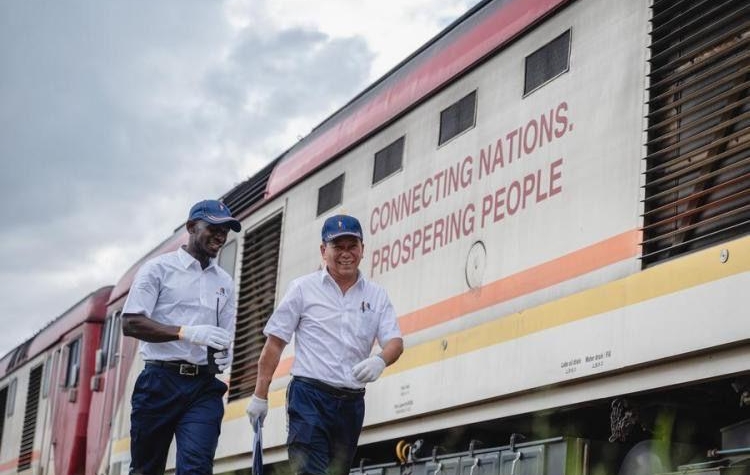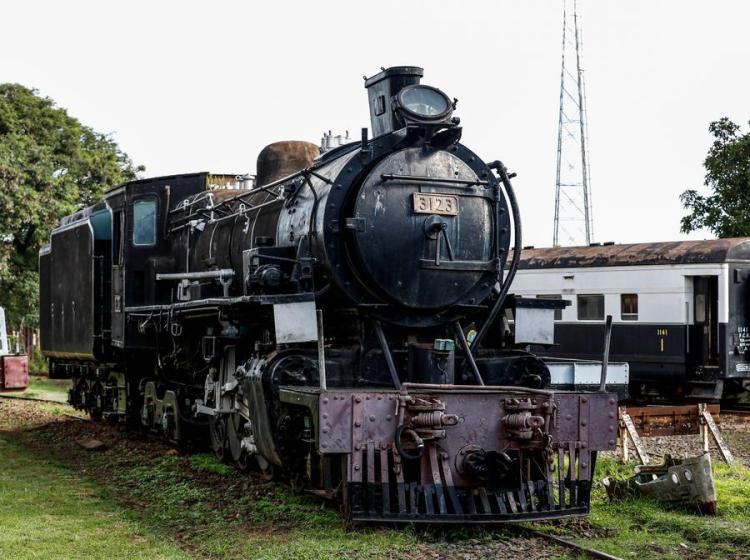
“It is not uncommon for a country to create a railway, but it is uncommon for a railway to create a country,” Sir Charles Eliot, then commissioner of British East Africa, made the bold statement in 1903.
Eliot, “who initiated the policy of white supremacy in the British East Africa Protectorate (now Kenya),” according to the Encyclopaedia Britannica website, was referring to the meter gauge railway built by British colonialists in East Africa between 1896 and 1901.
The railway, emblematic of Western civilization’s expansive reach, piped white settlers to the African continent in pursuit of adventure and colonial conquest and witnessed Kenya’s awakening process and struggle for independence.
“There are those who praised it (the railway) as a key component in Kenya’s birth, or we called the birth of a nation, and those who are more of saying that it played a role in colonizing Kenya,” Dennis Munene, executive director of the China-Africa Center, told Xinhua in a recent interview.
“We’re celebrating now our independence 60 years. And we will always continue to look behind on what happened. We are going to heal from the wounds and now push for Kenya to attain more development,” Munene said.

EUROPEAN PARTITION OF AFRICA
At the entrance of the Nairobi Railway Museum, the century-old railway, initially named the Uganda Railway after its destination, was displayed on a map of East Africa.
Built between 1896 and 1901, it started in the port city of Mombasa on the coast of the Indian Ocean and extended northwest to stop at Port Florence, now Kisumu, on the shores of Lake Victoria.
To understand the birth of the railway, it’s necessary to mention the Berlin Conference of 1884-1885. During the conference, Britain and other Western powers discussed rules for colonizing and partitioning Africa, such as “effective occupation.”
Ironically, not a single African representative attended this decisive conference about Africa’s fate. A week before it closed, the Lagos Observer commented, “the world had, perhaps, never witnessed a robbery on so large a scale.”
“Following the close of the conference, European powers expanded their claims in Africa such that by 1900, European states had claimed nearly 90 percent of African territory,” wrote the Encyclopedia of Africa.
Russian revolutionary leader Vladimir Lenin pointed out in his 1917 book Imperialism, the Highest Stage of Capitalism that “when nine-tenths of Africa had been seized (by 1900) when the whole world had been divided up, there was inevitably ushered in the era of monopoly possession of colonies and, consequently, of particularly intense struggle for the division and the redivision of the world.”
To tighten control over the “British East Africa,” the British government laid a railway to control the entire Nile River basin originating from Lake Victoria.
However, the project earned much resentment in the British parliament and media as its estimated cost of 5 million pounds was deemed exorbitant. British politician Henry Labouchere even wrote a poem mocking the railway as a “lunatic line.”
Yet, in the eyes of the colonizers, it was all worth it. The construction of the railway was not only a step in the partition of Africa but also a part of building the imperialistic colonial system.
“Whatever power dominates Uganda masters the Nile, the master of the Nile rules Egypt, the ruler of Egypt holds the Suez Canal,” wrote Charles Miller in his 1971 book The Lunatic Express: An Entertainment in Imperialism, from which the railway derived its well-known nickname.
BLOOD TAINTED “IRON SNAKE”
In the eyes of the local tribes, the Lunatic Express was an “Iron Snake.” An ancient tribal prophecy said the iron snake would someday cross their land and be a bad omen, creating trouble as it went.
In the main exhibition hall of the museum, a row of wood-framed photographs reproduces the birth of the “Iron Snake”: British engineers and officers in helmets, uniforms and riding boots standing on the roof of the locomotive, surrounded by ragged, barefoot laborers.
The railway’s construction was far more complex than the British had imagined, while the actual cost of life was immeasurable.
Without the assistance of machinery, the 931 km-long railway was built by workers holding simple tools. Supplies such as construction materials and fresh water had to be transported from elsewhere. Man-eating lions wandering in the savanna, tropical diseases like malaria and attacks by locals resisting the “Iron Snake” invasion all became the Death Reaper.
According to the museum, 2,493 workers had died by the time the railway was completed or four deaths for each mile of track laid.
This would probably surprise the British noblemen who later boarded the trains to chase fun as depicted in railway advertisements in the 1920s, one of which bid East Africa the “winter home for aristocrats.”
Setting foot on the African continent, the settlers aspired to turn the vast fertile land of Kenya into a “white man’s paradise,” racing horses and hunting on the rolling green hills and lush forests. They also established plantations of cash crops such as coffee and tea to process and sell in Europe.
Local pastoralists, such as the Maasai, were affected the most by the colonial expansion, and their resistance was brutally suppressed. In her book Moving the Maasai: A Colonial Misadventure, British author Lotte Hughes describes how many Maasai were forcibly moved into two reserves and robbed of the best part of their land. It was the same fate for the Kikuyu, another prominent tribe in the region.
This colonial economy has left a lasting impact on Kenya, and the pain is still felt.
In 2022, a group of Kenyans filed a case against the British government at the European Court of Human Rights over colonial-era land theft, torture and mistreatment, claiming that the local tribes from Kericho county were forcibly evicted in the early 20th century from their ancestral lands, a major tea-growing region farmed today by large multinationals. “The UK Government has ducked and dived, and sadly avoided every possible avenue of redress,” said the group’s lawyer Joel Kimutai Bosek.
“There is blood in the tea,” said Godfrey Sang, a historian whose grandfather’s land was doled out to white farmers.
ANTI-COLONIAL MOVEMENTS
After World War I, as more and more Europeans settled in the East African colony, little land was left that belonged to the indigenous people. “It is more than their land that you take away from the people whose native land you take. It is their past as well, their roots and their identity,” wrote Karen Blixen in her famous book Out of Africa.
In the 1930s and 1940s, a storm of resistance was brewing among local communities who had been stripped of lands. Their discontentment fed into various Kenyan nationalist movements, ultimately leading to the Mau Mau movement.
The Mau Mau, a militant anti-colonial group primarily composed of the Kikuyu people, convened under the slogan of “land and freedom” and quickly gained support among local communities.
Using the railway, nationalists could travel from one end of Kenya to the other to join political rallies to encourage Kenyans to fight for independence. It was also said people were using the railway to transport guns to those fighting for independence.
In October 1952, the British colonial government declared a state of emergency over the Mau Mau insurgency, which marked the beginning of a bloody oppression.
In 1956, the capture of rebel leader Dedan Kimathi marked the defeat of the Mau Mau movement, but the rebellion survived into the early 1960s. By the end of 1956, more than 11,000 rebels had been killed in the fighting, according to the website of Encyclopaedia Britannica.
On Dec. 12, 1963, Kenya became fully independent from colonial rule. A wave of decolonization swept across Africa in the 1950s and 1960s, leading to the independence of some 30 African countries.
FROM LUNATIC EXPRESS TO MADARAKA EXPRESS
Kenya broke the shackles of colonial rule sixty years ago, but the legacy of the colonial economy continued to constrain the country’s development for decades.
Today, when looking out of the train windows of the old railway, tourists can enjoy Kenya’s beautiful landscape and diverse wildlife while spotting tea plantations, some of which are still owned by Western multinationals.
Meanwhile, a notable change captured their attention: The new Mombasa-Nairobi Standard Gauge Railway (SGR) built by China runs mainly in parallel with the old one.
The SGR, dubbed the Madaraka Express, was launched on May 31, 2017, a day before Madaraka Day, which commemorates Kenya’s internal self-rule on June 1, 1963.
The new train drastically reduced travel time and the costs of freight service. It emerged as the preferred choice for commuters, pivotal in stimulating commerce and empowering smaller towns along its corridor.
In the railway museum, a locomotive miniature of the SGR is on display, bearing a slogan on the side of the carriages that reads “connecting nations, prospering people.”
The old Kenya-Uganda railway was more of an extractive railway where colonial masters used to get raw materials from the hinterland to the Indian Ocean for shipping to their countries,” Munene said.
“The SGR, which is a partnership between China and Kenya, is development-oriented. It helps Kenya to integrate with the other East African countries. It’s helping Kenya to grow in terms of its economic expansion. It’s creating what we call a fast and efficient mode of transport for goods and passengers,” he said.
The new railway has operated seamlessly for over 2,300 days, ferrying millions of passengers and tons of goods, contributing significantly to Kenya’s socio-economic growth. Local drivers, technicians and attendants, trained by Chinese professionals, ensure the smooth operation of the railway.
The Madaraka Express epitomizes the Belt and Road cooperation between China and Kenya. Over the past years, such cooperation projects have helped enhance infrastructure connectivity across the continent and boost intra-African trade.
From the Lunatic Express to the Madaraka Express, the colonial past represented by the old railway is gradually fading away. A bright future brought by the new railway is emerging









































































